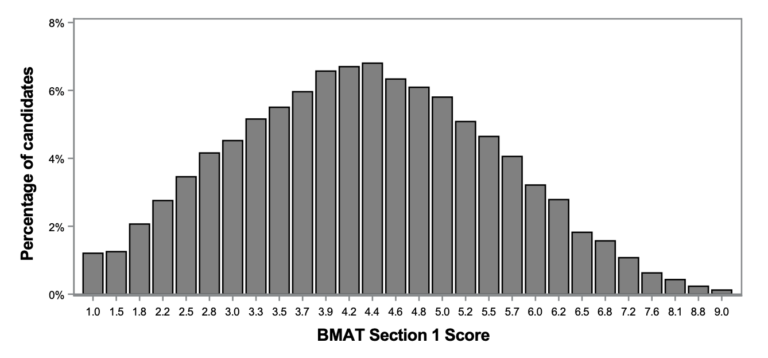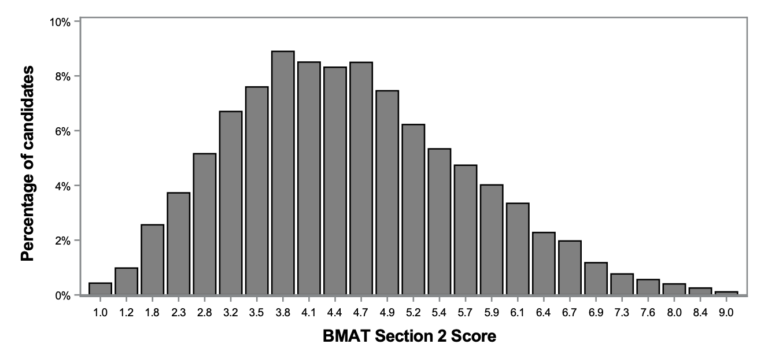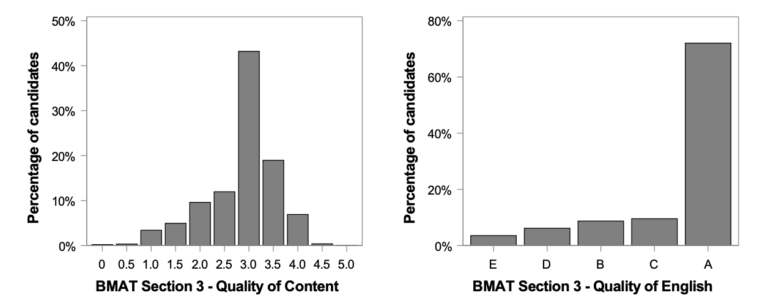The BMAT has now been discontinued. All applicants for undergraduate medicine in the UK will be required to sit the University Clinical Aptitude Test (UCAT) for their application. Check out our wide selection of Free UCAT Guides to get started with your preparation.
Up until now, most of your exams have probably been scored as a percentage, with the aim of getting 100% (or as close as you can). The scoring of the BMAT is slightly different, and this guide will help you decipher how this works and how to interpret your results.
By doing so, you can pick up some strategic tips about how to approach the exam, and learn how to play to your strengths when considering how the BMAT fits in with your all-important medicine application to universities.
BMAT 2022 Scores
Below are the most recent BMAT scores for 2023.
BMAT Section 1 Score Distribution Chart 2023
BMAT Section 2 Score Distribution Chart 2023
In Sections 1 and 2, the clearest trend we can see this year is that distributions are much rounder and skewed to the lower end of the scoring system when compared to previous years (see more about that here). The most common scores this year were 4.4 for Section 1 and 3.8 for Section 2, which is just below the halfway point of the marking scheme. In Section 1, scores of over 6.0 were very rare, with around 10% of applicants achieving it.
BMAT Section 3 Score Distribution Chart 2023
In Section 3, applicants this year scored very well in Quality of English with nearly 80% scoring an A. Meanwhile, Quality of Content was more average, with a most common score of 3. However, neither of these figures are unusual. In fact, these distribution graphs are nearly identical to previous years!
How do BMAT scores work?
BMAT Section 1 & 2 Scoring Explained
Each question in these Sections is worth one raw mark (no matter the “difficulty”!). Knowing this means you should divide your time as equally as possible between questions. Some easy questions will take seconds, but you should make sure you don’t spend ages on the harder questions and miss out on easy ones that might be at the end of the test. They’re all worth the same at the end of the day!
Additionally, there is no negative marking (or to side-step around that double negative: a wrong answer is not penalised). This means you should make sure that by the end of the exam, you’ve selected an answer for each question. Even if some of these are completely random guesses, there is still a chance it could be right and there is no harm if it is wrong – to quote the age-old adage “the only wrong answer is no answer”.
BMAT Score Conversion Tables
What is a BMAT Score?
Your raw marks at the end of the BMAT (e.g. the amount of questions you got right) is not the final score that you will be judged on by universities. Instead, you will be judged by your BMAT Score for Sections 1 and 2. Bear in mind that Section 3 does not follow this convention due to its different marking scheme.
Your total raw mark is correlated to a BMAT score for each Section ranging from 1 (low) to 9 (high). It can be a bit tricky to understand this score as the conversion is not linear. The score conversion will charge subtly from year to year depending on the perceived difficulty of the paper. However, this conversion is decided by the examining body of the BMAT (Cambridge Assessment Admissions Testing), so it does not change between universities.
Overall, it typically ends up that 5.0 is roughly half the raw marks, 6.0 is scored by the best students, 7.0 and higher is only achieved in exceptional cases.
Below are the most recent calculated conversion tables for you to see where your score may fall. We must really emphasise that the conversion changes year upon year, so this will give you a good guideline but may not be prescriptive for every year.
BMAT Section 1 Score Conversion Table 2021
| Raw Marks [Section 1] | BMAT Score |
|---|---|
| 4 | 2.3 |
| 6 | 2.8 |
| 8 | 3.2 |
| 10 | 3.6 |
| 12 | 4.0 |
| 14 | 4.4 |
| 16 | 4.7 |
| 18 | 5.0 |
| 20 | 5.4 |
| 22 | 5.7 |
| 24 | 6.0 |
| 26 | 6.3 |
| 28 | 6.7 |
| 30 | 7.2 |
| 32 | 7.8 |
| 34 | 8.4 |
| 35 | 9.0 |
BMAT Section 2 Score Conversion Table 2021
| Raw Marks [Section 2] | BMAT Score |
|---|---|
| 1 | 1.5 |
| 3 | 2.5 |
| 5 | 3.1 |
| 7 | 3.7 |
| 9 | 4.2 |
| 11 | 4.6 |
| 13 | 4.9 |
| 15 | 5.2 |
| 17 | 5.5 |
| 19 | 6.1 |
| 21 | 6.7 |
| 23 | 7.6 |
| 25 | 8.2 |
| 27 | 9.0 |
As you can see, the pool of potential scores for Section 2 is less due to the smaller amount of questions. However, the two sections are proportionally similar to each other overall. The BMAT marking scheme isn’t really something you’re going to need to think about when actually sitting the test. At the end of the day, all that you’ll need to worry about with your BMAT score is that you get as many questions correct as you can!
What you need to take away from this and the score distribution charts is that whilst it may be nice to aspire to, full marks are not required to give you even an exceptional score of 7.0+. Again, this feeds into the whole idea of not spending ages tied to one question, as you do not need to get every single answer correct.
It’s likely that as you start practising papers and getting marks, you want to see how you fare on this BMAT score. When using BMAT.Ninja (which is included in our BMAT Bundle) you’ll be able to view your calculated BMAT score anytime you complete a mock exam, letting you know exactly what you can expect from your BMAT Score!
Need some extra guidance in boosting your BMAT score?
Learn everything there is to know about the BMAT, with our BMAT Bundle and be guided by a tutor who scored in the top 10% – meaning you’re truly getting expert help.
Want to learn how to smash the BMAT, then this bundle is the one for you…



Boost your BMAT score and get your place at med school.
Learn everything there is to know about the BMAT, with our BMAT Bundle and be guided by a tutor who scored in the top 10% – meaning you’re truly getting expert help.
BMAT.Ninja
BMAT.Ninja

UCAT TUTORING BUNDLE
Get UCAT support from 6med to score highly and earn your offer.
Prepare yourself for the UCAT with one-to-one tuition from a UCAT expert, as well as comprehensive resources, an expert preparation course and full access to UCAT.Ninja, available as soon as you sign up.
UCAT.Ninja
UCAT.Ninja
BMAT Section 3 Scoring Explained
There is no score conversion for Section 3. Instead, your Quality Of English is marked on a scale of A (high) to C to E (low), and your Quality Of Content is scored from 0 (low) to 5 (high). Here are the criteria:
| Quality Of English | Quality Of Content | ||
|---|---|---|---|
| Band A | Good use of English – clear, fluent, good use of grammar and vocabulary | Score 1 | The essay has some bearing on the question but does not address it fully |
| Band C | Reasonably clear use of English – reasonably fluent, some errors | Score 2 | Addresses most of the question, but has significant elements of confusion |
| Band E | Rather weak use of English – not easy to follow, faulty grammar | Score 3 | Reasonably well-argued, may have weakness in the argument |
| Score 4 | Good answer with few weaknesses, all aspects of the question are addressed | ||
| Score 5 | Excellent answer with no significant weaknesses | ||
As this can be subjective, two examiners mark this Section (unlike the other two which are machine-marked) and if the two marks are the same, or no more than one mark apart, you get the average. For letters, averages work like this: AA = A, AC=B, CC=C, CE=D, EE=E.
For example: if one examiner gave you 3C and another gave you 4A, the average would be 3.5B. If there is a larger discrepancy, the essay gets marked again and the mark is reviewed by a BMAT Assessment Manager.
What are Good, Average and Low BMAT Scores?
It’s typically agreed upon that there are three categories of BMAT scores which determine how well you’ve done in the test. These aren’t official by any means, but looking at data from previous admissions cycles shows a pattern in regards to the frequency of scores. These categories are separated as follows:
What is a Good BMAT Score?
Firstly, there are Good (or High) BMAT scores. Most people agree that anything from 6.0 and above is considered a Good score. When looking at a typical distribution graph for BMAT scores, 6.0 is around the point where the number of applicants begin to drop down, showing that these scores are much harder to obtain. Scoring a 6.0 or more is going to make your application very competitive at any UK medical school, although you’re still going to need a strong application alongside it.
What is an Average BMAT Score?
An Average BMAT score is seen to be anything between 4.0 and 6.0 as the majority of applicants will achieve a score in this range. Due to this, scoring in this range means your BMAT score isn’t particularly going to make you stand out. It will usually be enough to pass any thresholds in place, but you will be relying more on the rest of your application in impress the examiners.
What is a Low BMAT Score?
A Low BMAT score will, of course, be anything below 4.0. Calling these “Low” scores may sound a bit disheartening, but getting a score in this range doesn’t lead to instant failure. Many universities have been know to give offers to applicants who scored in the 3.0s and even 2.0s on occasion. The issue is that you’re going to need to ensure the rest of your application is exceptional, such as your personal statement and work experience. Admissions teams understand that exams aren’t some people’s strengths, so providing evidence of your skills in a practical way can potentially save your application.
The scores of the BMAT can be a bit confusing when talking about averages. Universities will typically receive individual scores for each Section of the BMAT. However, when reporting on previous year’s results, it can be a bit up in the air as to how they are presented. Typically, you’ll see one of three methods:
- The scores for each section will be present individually.
- The scores for Sections 1 and 2 will be added together to make a larger score out of 18.0.
- The average between the scores from Sections 1 and 2 will be calculated and presented out of 9.0.
Some universities have different scoring methods to this, such as Brighton and Sussex Medical School who score the full exam out of 37.
Also, this scoring method does not take Section 3 into account. Most universities will always consider Section 3 at some point in the process, so what do Good, Average and Low score looks like for it?
Good Section 3 BMAT Score
A good score for Section 3 will fall into Band A and have a score of 4-5.
Average Section 3 BMAT Score
An average score is typically going to be a Band C with a score of 2-4.
Low Section 3 BMAT
Score
A low Section 3 score fall under a Band E and a score between 1-2.
BMAT Universities
As you may already know, there are only 8 medical schools that use the BMAT in the UK. With so few unis requiring the exam, you would expect there to not be too much variation in how they use your score. Thankfully, you’d be fairly correct in that assumption!
In general, the BMAT scores are used to decide who to invite for interview and holistically, for who to extend a place to. Some Universities do not officially announce how this is done, so getting as good a score as possible is important. Additionally, some Universities place more emphasis on a specific Section’s score (for example, Oxford weigh Section 1 and 2 more) and some only use cut-offs in certain Sections such as Section 3.
You can learn more about how each university uses your BMAT score in our BMAT Universities Guide, but one thing that we feel is extra important to consider the standards of score that each university expect. Using the metrics of Good, Average and Low BMAT Scores, we have categorised each BMAT University based on their cut-off scores and statistics from previous admissions cycles.
Good Score BMAT Universities
Average Score BMAT Universities
Low Score BMAT Universities
These are by no means official rankings and they do not reflect the quality of teaching in these schools in any way. The purpose of these rankings are simply to categories the universities based on their BMAT statistics. Lower scoring universities aren’t necessarily easier to get into than higher scoring ones, as lower BMAT scores will still need to be supported with stronger applications in order to be considered. Essentially, the lower the BMAT score, the higher quality the rest of your application needs to be.
BMAT Cut-Off
Although not a standard, BMAT cut-off scores are used by some unis. This can vary from year to year, just as the test and the cohort of applicants vary each year. You can generally use the previous few years as a guide but be mindful that they do indeed move around a bit (although it is very unlikely that there will be a dramatic change).
There is a big difference between an average score and a cut-off. By virtue of an average for successful applicants, a fair few will have scored below the average, so remember the holistic nature of the process and do not be scared to use a choice if you are hovering slightly below an average, but have a strong application.
These are the cut-off requirements for each BMAT universities:
Brighton and Sussex Medical School: 17.3/37
Imperial College London: TBA
Lancaster University: 8.9/24
University of Oxford: No Cut-off
University of Cambridge: No Cut-off
Keele University: TBA
University College London: No Cut-off
We've got all the tips and tricks you need to score highly on the BMAT.
With our BMAT Bundle, cover Sections 1, 2 and 3 of the BMAT in detail with tips and strategies to ensure you achieve the highest possible score.
Want to learn how to smash the BMAT, then this bundle is the one for you…



Prepare for the BMAT with expert support from 6med.
Ace the BMAT with comprehensive support from 6med. Access expert revision and practice material as soon as you sign up.
BMAT Online Course
BMAT Online Course

UCAT TUTORING BUNDLE
Get UCAT support from 6med to score highly and earn your offer.
Prepare yourself for the UCAT with one-to-one tuition from a UCAT expert, as well as comprehensive resources, an expert preparation course and full access to UCAT.Ninja, available as soon as you sign up.
UCAT.Ninja
UCAT.Ninja
Analysis of previous years’ BMAT scores
In this section, we’ll go into a little more detail about the results of past BMAT scores.
Section 1 Scores
Looking at previous years’ scores:
- In 2019, around ~58% of candidates scored between 3.5 and 5.5 in section 1.
- In 2020, this reduced slightly to ~56.5% between 3.5 and 5.5.
- In 2021, we saw a large increase with ~63% achieving a score between 3.5 and 5.5.
- In 2022, this sharply dropped to ~49% achieving a score between 3.5 and 5.5.
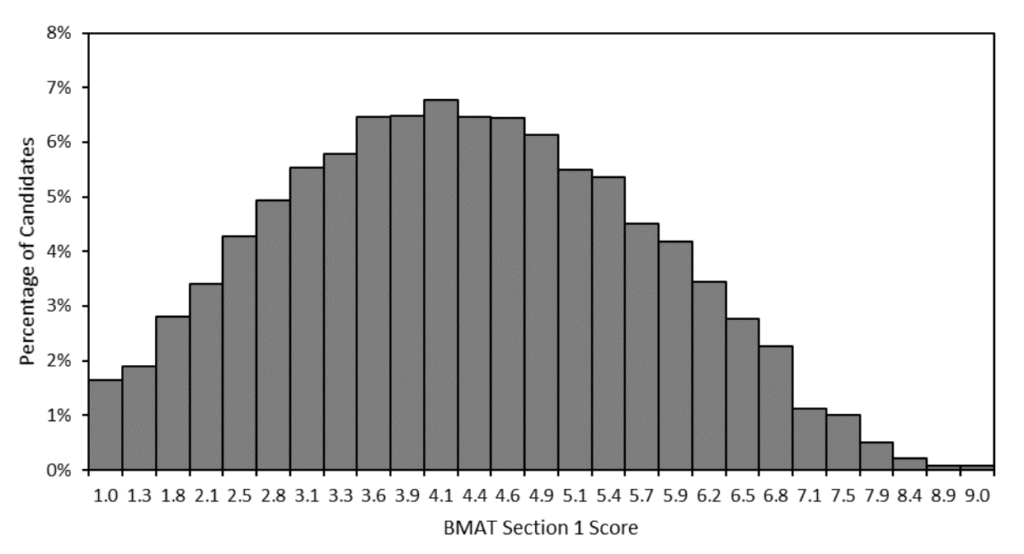
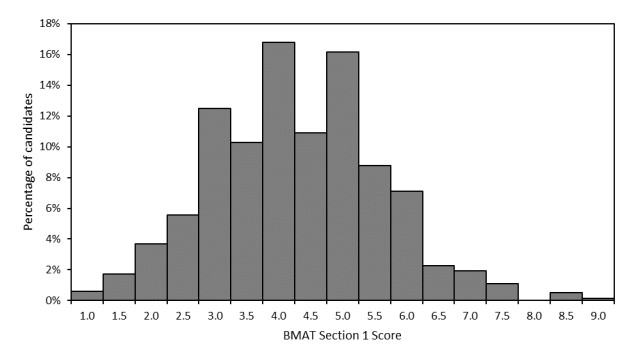

Section 2 Scores
Looking at previous years’ scores:
- In 2020, the mean score was 4.6, compared to 3.5 – 4.0 in 2019.
- Around 45% of candidates scored above 4.6 in 2020.
- The mean score of 4.0 puts 2021 below the 2020 averages, but a higher 48% of candidates scored a 4.5 or above in 2021.
- Around 40% of candidates then scored about 4.5 in 2022.

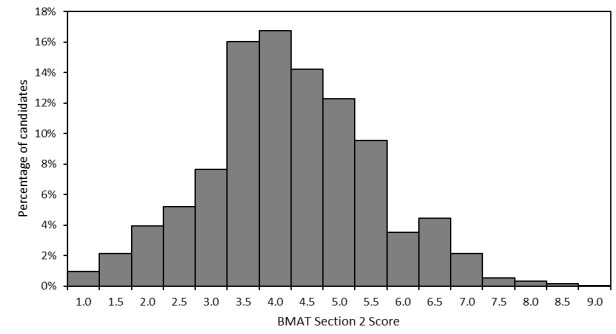

Section 3 Scores
Looking at previous years’ scores:
- 3A is generally the most popular score in Section 3. In 2021 and 2022, 75% of test-takers achieved a score of A for their quality of English.
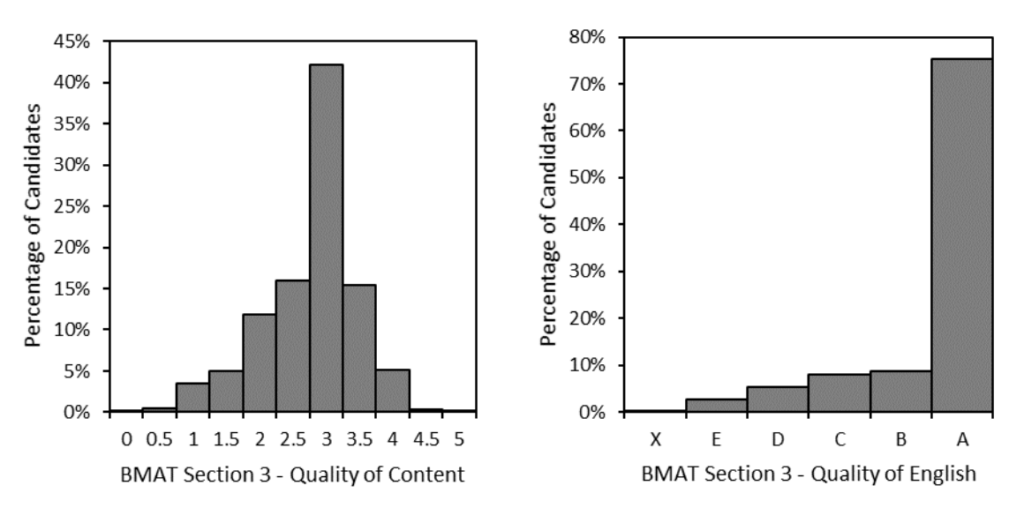


What Difference Does A-Level Choice Make To Your Score?
The logic behind looking at this is that some students feel that they may be disadvantaged in Section 2 if they have not taken certain subjects at A-level (ie. Maths, Further Maths, Biology, Chemistry and Physics). There is a pending request for more recent results, but in terms of past results, Cambridge has released a set of statistics they compiled.
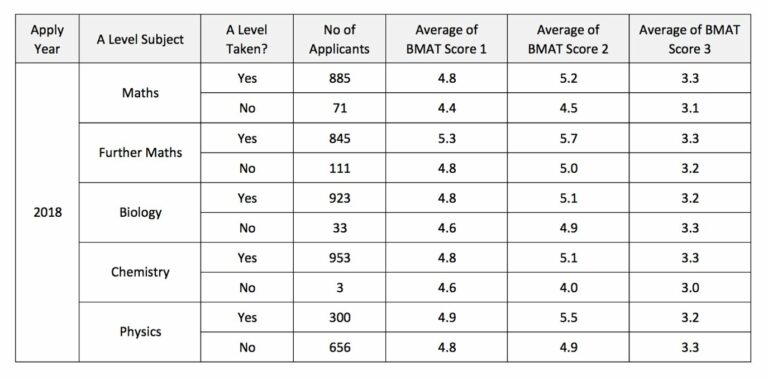
Looking at these statistics, perhaps not studying Maths or Chemistry could result in a lower score (or even Physics to a lesser extent). However, it should certainly not be enough to put you off taking the BMAT if you do not take one of these subjects.
Every year, huge numbers of applicants get in who do not take this combination (including myself!). Additionally, these are results from Cambridge ONLY, and do not represent national averages or those from other unis. What it should do is inspire you to brush up on subjects you have dropped and give them a bit more care and attention when it comes to your preparation.
BMAT Remarking
Most people cannot accurately tell how well or badly they did in such an exam but if you end up opening your results and feeling very shocked, there is a process you can go through to get a remark. You must submit the result enquiry form (or if you sit the exam in November, your centre must submit it on your behalf).
You have to pay a fee of about £46 but if your result changes, there is no charge. The remark should arrive within 5 working days, so it should not delay your application. A word of caution, your result can go up or down from this process, so only pursue it if you reasonably believe there has been an error.
Final Comments
That essentially sums up the scoring and results of the BMAT. The key things to remember are the techniques you can implement to maximise scores (eg don’t spend too much time on one question as they are all worth the same marks).
Additionally, remember that each University will use the BMAT differently, so consider playing to your strengths when making applications, especially if you have your results prior to submitting your choices. Good luck with the test and application process as a whole!
Need some extra guidance in boosting your BMAT score?
Learn everything there is to know about the BMAT, with our BMAT Bundle and be guided by a tutor who scored in the top 10% – meaning you’re truly getting expert help.
Want to learn how to smash the BMAT, then this bundle is the one for you…



Boost your BMAT score and get your place at med school.
Learn everything there is to know about the BMAT, with our BMAT Bundle and be guided by a tutor who scored in the top 10% – meaning you’re truly getting expert help.
BMAT.Ninja
BMAT.Ninja

UCAT TUTORING BUNDLE
Get UCAT support from 6med to score highly and earn your offer.
Prepare yourself for the UCAT with one-to-one tuition from a UCAT expert, as well as comprehensive resources, an expert preparation course and full access to UCAT.Ninja, available as soon as you sign up.
UCAT.Ninja
UCAT.Ninja
